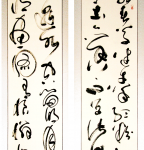Bi-Directionnality
When left-to-right text is mixed with right-to-left in the same paragraph, each text should be written in its own direction, known as “bi-directional text.”
Material Used
In case you want to try, you’ll want to know what material to use. There is a lot of typical tools, such as brush pens, scissors, a knife to cut the pens and an ink pot. But the traditional instrument of the Arabic calligrapher is the qalam, a pen made of dried reed or bamboo. “The traditional way to hold the pen,” wrote Safadi in 1987, “is with middle finger, forefinger and thumb well spaced out along the [pen's] shaft. Only the lightest possible pressure is applied.”
As for the ink, you have many options: black and brown (often used because their intensity and consistency can be varied greatly) as well as yellow, red, blue, white, silver and gold. The important thing is that the greater strokes of the composition be very dynamic in their effect.
A Few Techniques
The development of Arabic calligraphy led to several decorative styles that were intended to accommodate special needs or tastes and to please or impress others. Here are a few outstanding techniques and scripts.
Gulzar is defined by Safadi (1979) in Islamic calligraphy as the technique of filling the area within the outlines of relatively large letters with various ornamental devices, including floral designs, geometric patterns, hunting scenes, portraits, small script and other motifs. Gulzar is often used in composite calligraphy, where it is also surrounded by decorative units and calligraphic panels.
Maraya or muthanna is the technique of mirror writing, where the composition on the left reflects the composition on the right.
Tughra is a unique calligraphic device that is used as a royal seal. The nishanghi or tughrakesh is the only scribe trained to write tughra. The emblems became quite ornate and were particularly favored by Ottoman officialdom.
In zoomorphic calligraphy, the words are manipulated into the shape of a human figure, bird, animal or object.
| < Prev | Next > |
|---|
- 2009-03-25 - 得“自然”,备“古雅”--评米芾书法(转载)
- 2008-12-15 - 书法浅识(四) 转载
- 2008-12-14 - 书法浅识(三) 转载
- 2008-12-13 - 书法浅识(二) 转载
- 2008-12-13 - 书法浅识(一) 转载
- 2008-12-10 - 字里千秋,中国的书法艺术
- 2008-12-02 - 汉字书法的意境美
- 2008-11-08 - "丑"之为美:兼谈书法的审美标准(书法美学)
- 2008-09-28 - Ding Shimei "Yin Yang" (2008AD) Seal Script,
- 2008-09-16 - 转文恒山

















